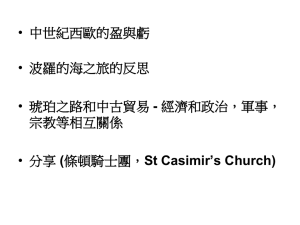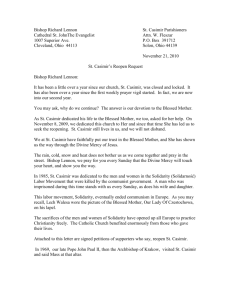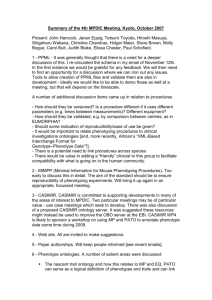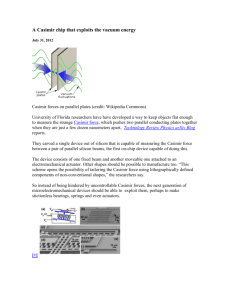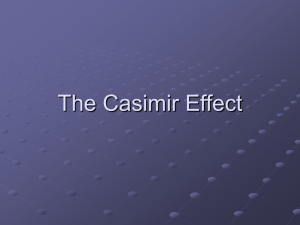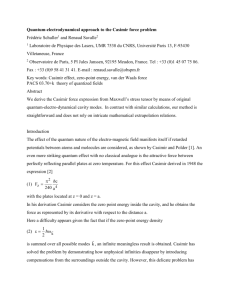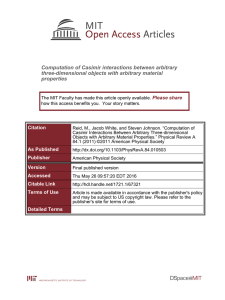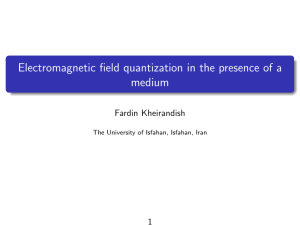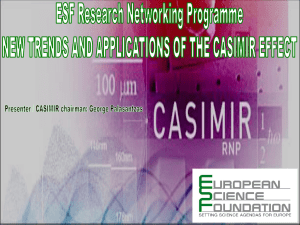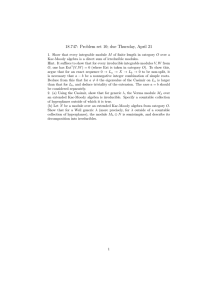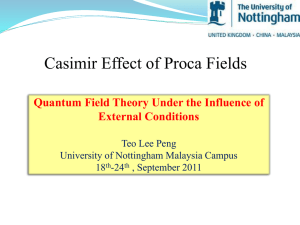Computation of Casimir interactions between arbitrary three-dimensional objects with arbitrary
advertisement
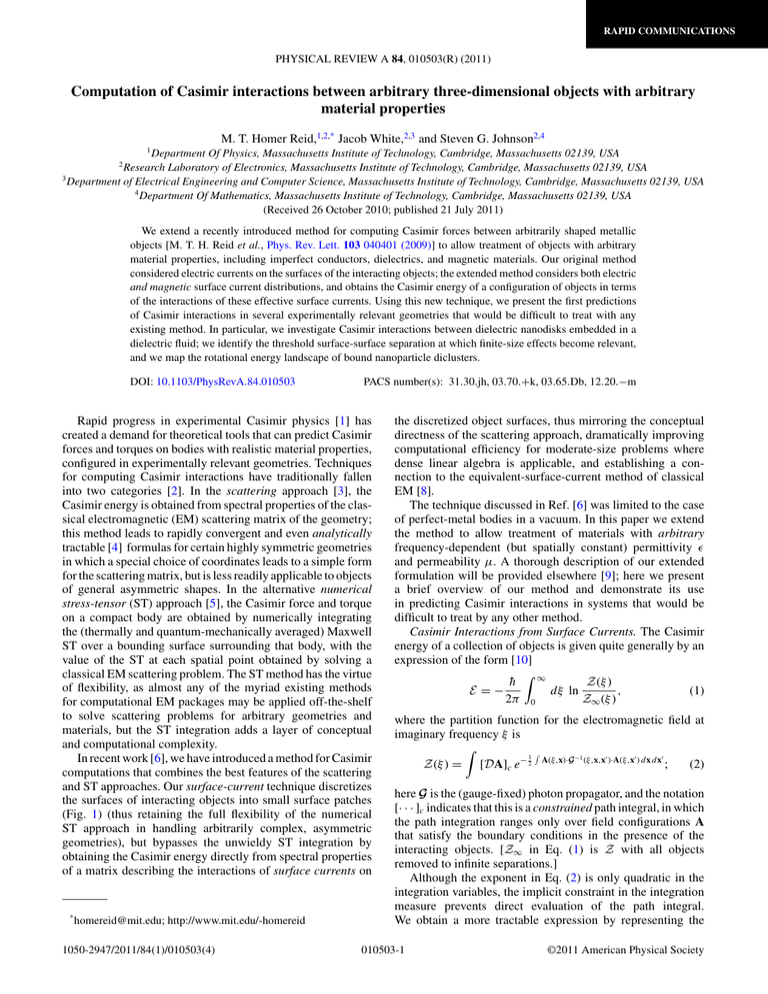
RAPID COMMUNICATIONS
PHYSICAL REVIEW A 84, 010503(R) (2011)
Computation of Casimir interactions between arbitrary three-dimensional objects with arbitrary
material properties
M. T. Homer Reid,1,2,* Jacob White,2,3 and Steven G. Johnson2,4
1
Department Of Physics, Massachusetts Institute of Technology, Cambridge, Massachusetts 02139, USA
2
Research Laboratory of Electronics, Massachusetts Institute of Technology, Cambridge, Massachusetts 02139, USA
3
Department of Electrical Engineering and Computer Science, Massachusetts Institute of Technology, Cambridge, Massachusetts 02139, USA
4
Department Of Mathematics, Massachusetts Institute of Technology, Cambridge, Massachusetts 02139, USA
(Received 26 October 2010; published 21 July 2011)
We extend a recently introduced method for computing Casimir forces between arbitrarily shaped metallic
objects [M. T. H. Reid et al., Phys. Rev. Lett. 103 040401 (2009)] to allow treatment of objects with arbitrary
material properties, including imperfect conductors, dielectrics, and magnetic materials. Our original method
considered electric currents on the surfaces of the interacting objects; the extended method considers both electric
and magnetic surface current distributions, and obtains the Casimir energy of a configuration of objects in terms
of the interactions of these effective surface currents. Using this new technique, we present the first predictions
of Casimir interactions in several experimentally relevant geometries that would be difficult to treat with any
existing method. In particular, we investigate Casimir interactions between dielectric nanodisks embedded in a
dielectric fluid; we identify the threshold surface-surface separation at which finite-size effects become relevant,
and we map the rotational energy landscape of bound nanoparticle diclusters.
DOI: 10.1103/PhysRevA.84.010503
PACS number(s): 31.30.jh, 03.70.+k, 03.65.Db, 12.20.−m
Rapid progress in experimental Casimir physics [1] has
created a demand for theoretical tools that can predict Casimir
forces and torques on bodies with realistic material properties,
configured in experimentally relevant geometries. Techniques
for computing Casimir interactions have traditionally fallen
into two categories [2]. In the scattering approach [3], the
Casimir energy is obtained from spectral properties of the classical electromagnetic (EM) scattering matrix of the geometry;
this method leads to rapidly convergent and even analytically
tractable [4] formulas for certain highly symmetric geometries
in which a special choice of coordinates leads to a simple form
for the scattering matrix, but is less readily applicable to objects
of general asymmetric shapes. In the alternative numerical
stress-tensor (ST) approach [5], the Casimir force and torque
on a compact body are obtained by numerically integrating
the (thermally and quantum-mechanically averaged) Maxwell
ST over a bounding surface surrounding that body, with the
value of the ST at each spatial point obtained by solving a
classical EM scattering problem. The ST method has the virtue
of flexibility, as almost any of the myriad existing methods
for computational EM packages may be applied off-the-shelf
to solve scattering problems for arbitrary geometries and
materials, but the ST integration adds a layer of conceptual
and computational complexity.
In recent work [6], we have introduced a method for Casimir
computations that combines the best features of the scattering
and ST approaches. Our surface-current technique discretizes
the surfaces of interacting objects into small surface patches
(Fig. 1) (thus retaining the full flexibility of the numerical
ST approach in handling arbitrarily complex, asymmetric
geometries), but bypasses the unwieldy ST integration by
obtaining the Casimir energy directly from spectral properties
of a matrix describing the interactions of surface currents on
*
homereid@mit.edu; http://www.mit.edu/-homereid
1050-2947/2011/84(1)/010503(4)
the discretized object surfaces, thus mirroring the conceptual
directness of the scattering approach, dramatically improving
computational efficiency for moderate-size problems where
dense linear algebra is applicable, and establishing a connection to the equivalent-surface-current method of classical
EM [8].
The technique discussed in Ref. [6] was limited to the case
of perfect-metal bodies in a vacuum. In this paper we extend
the method to allow treatment of materials with arbitrary
frequency-dependent (but spatially constant) permittivity and permeability μ. A thorough description of our extended
formulation will be provided elsewhere [9]; here we present
a brief overview of our method and demonstrate its use
in predicting Casimir interactions in systems that would be
difficult to treat by any other method.
Casimir Interactions from Surface Currents. The Casimir
energy of a collection of objects is given quite generally by an
expression of the form [10]
∞
h̄
Z(ξ )
E =−
,
(1)
dξ ln
2π 0
Z∞ (ξ )
where the partition function for the electromagnetic field at
imaginary frequency ξ is
1
−1
Z(ξ ) = [DA]c e− 2 A(ξ,x)·G (ξ,x,x )·A(ξ,x ) dx dx ;
(2)
here G is the (gauge-fixed) photon propagator, and the notation
[· · · ]c indicates that this is a constrained path integral, in which
the path integration ranges only over field configurations A
that satisfy the boundary conditions in the presence of the
interacting objects. [Z∞ in Eq. (1) is Z with all objects
removed to infinite separations.]
Although the exponent in Eq. (2) is only quadratic in the
integration variables, the implicit constraint in the integration
measure prevents direct evaluation of the path integral.
We obtain a more tractable expression by representing the
010503-1
©2011 American Physical Society
RAPID COMMUNICATIONS
M. T. HOMER REID, JACOB WHITE, AND STEVEN G. JOHNSON
PHYSICAL REVIEW A 84, 010503(R) (2011)
of this sort are ubiquitous in equivalence-principle techniques
for EM field computation [8] and form the basis of the
boundary-element method of computational EM [13].
Inserting the explicit constraint (3) into the path integral (2)
allows us to relax the implicit constraint [· · · ]c , whereupon the
path integral over the A field may be performed analytically
Z(ξ ) =
−1
DA DK DN e− 2 AG A+i A·[L
∼ DK DN exp{−Sξ [K,N]},
1
E
K+LH N]
(4)
where ∼ denotes equality up to constant factors that cancel in
the ratio in Eq. (1), and where the effective action
T E E
K
L GL
·
Sξ [K,N] =
H
L
GLE
N
FIG. 1. (Color) Casimir force between silicon and teflon spheres
and cubes immersed in ethanol, normalized by the PFA predictions
(see text). For the sphere-sphere case, the solid circles represent data
computed using the methods described in this paper, while the thick
solid line reproduces data from Ref. [7]. For the other three cases, the
solid and hollow circles represent data computed using the methods
described in this paper, and the dotted lines are a guide to the eye.
constraints on the A field explicitly via functional δ functions
[11,12]. Consider a single point x on the surface of an object
in our geometry. The boundary conditions at x are that the
components of E and H tangential to the object surface are
continuous as we pass from the interior to the exterior of the
object at x
out
Ein
(x) = E (x),
LE GLH
LH GLH
K
·
dx,
N
describes the interactions of electric and magnetic surface currents on the bodies of the interacting objects. The frequencydependent material parameters (ξ ),μ(ξ ) of all interacting
objects, and of the medium in which they are embedded, enter
into Sξ through LE ,LH , and G.
Discretization. To evaluate Eq. (4) for a given collection
of objects, we now proceed as in Ref. [6] by discretizing
the surfaces of the objects into small planar triangles [14].
We introduce a set [15] of localized vector-valued basis
functions {fα } and approximate the surface currents K(x),N(x)
as expansions in the finite set {fα }
K(x) ≈
α
Kα fα (x),
N(x) ≈
Nα fα (x).
α
out
Hin
(x) = H (x).
We introduce two two-dimensional δ functions that impose
these constraints at x
∞ ∞
dK1 dK2 iK·[Ein (x)−Eout (x)]
out
(x)
−
E
(x))
=
e
,
δ(Ein
2
−∞ −∞ (2π )
∞ ∞
dN1 dN2 iN·[Hin (x)−Hout (x)]
out
δ(Hin
(x)
−
H
(x))
=
e
,
2
−∞ −∞ (2π )
where we may think of the Lagrange multipliers K and N as
two-component vectors living in the tangent space to the object
surface at x. Aggregating the corresponding δ functions for all
points x on all object surfaces, we obtain an explicit functional
δ function constraining the electromagnetic field to satisfy the
boundary conditions
E
H
δ[A] = DK DN e {iK·L A+iN·L A} dx ,
(3)
where the integration in the exponent is over the surfaces of
all objects in our geometry, the path integrations range over
all possible tangential vector fields K(x),N(x) on the object
surfaces, and LE ,LH are differential operators that act on A
to yield E and H. Because K and N, respectively, enforce the
boundary conditions on the electric and magnetic fields, it is
tempting to interpret these tangential vector fields as electric
and magnetic surface current distributions on the surfaces of
the interacting objects. Effective surface current distributions
FIG. 2. (Color) Casimir force between puck-shaped polystyrene
and doped-silicon (dopant density ρ) nanoparticles immersed in
ethanol. The dotted curves indicate the force on slabs of the same
materials and thickness but infinite cross-sectional area [7]. (Material
properties are taken from Ref. [7].)
010503-2
RAPID COMMUNICATIONS
COMPUTATION OF CASIMIR INTERACTIONS BETWEEN . . .
The functional integral in Eq. (4) becomes a finite-dimensional
Gaussian integral
K K −Sξ [K,N]
dKα dNα e− N ·M(ξ )· N
DK DN e
∼
∼ [det M(ξ )],−1/2 ,
and, inserting into Eq. (1), the Casimir energy becomes
∞
h̄
det M(ξ )
E=
,
dξ ln
2π 0
det M∞ (ξ )
(5)
(6)
while differentiating with respect to the position of an object
gives the Casimir force on that object
∞
h̄
∂M
Fi = −
dξ Tr M−1 ·
.
(7)
2π 0
∂xi
The matrix M describes interactions among the effective
electric and magnetic surface currents. More specifically, each
pair of localized basis functions (fα ,fβ ) corresponds to a 2 × 2
block of M of the form
fα |GEE |fβ fα |GEM |fβ Mαβ =
,
fα |GME |fβ fα |GMM |fβ where GME is a dyadic Green’s function representing the
magnetic field due to a point electric dipole source.
Comparison to the BEM. The matrix M has precisely the
same form as the matrix that arises in the boundary-element
method (BEM) for electromagnetic scattering problems [13].
PHYSICAL REVIEW A 84, 010503(R) (2011)
Indeed, once we have implemented the computational machinery needed to evaluate Eq. (7), we could alternatively
use this same machinery to compute Casimir forces in a
different way, namely, by numerically integrating the ST
over a bounding surface, with the value of the ST at each
spatial quadrature point obtained by solving a BEM scattering
problem [16]. This procedure would entail solving linear
systems M · X = B for multiple vectors B, which, in practice,
would be handled by first decomposing M into triangular
factors. Such a factorization step is also required for numerical
evaluation of the determinant or trace expressions in Eqs. (6)
and (7). However, in our formulation, this factorization step
is all that is required, with the Casimir energy and force then
obtained immediately from the simple relations (6) and (7);
in contrast, the ST method requires extensive preprocessing
and postprocessing, in addition to the factorization of the
BEM matrix, to evaluate the ST integral. Thus, in addition
to the conceptual simplicity of our Eqs. (6) and (7) as
compared to the ST formulation, our method is significantly
more computationally efficient than the ST approach, at least
as long as we consider problems of moderate size (N ≡
dim M 104 ), for which direct linear-algebra methods are
feasible.
As an explicit demonstration of this computational advantage, the three points represented by hollow circles
on the cube-cube data curve in Fig. 1 were computed
by the ST-integration method using our BEM code. The
resulting force predictions agree with the predictions of
FIG. 3. (Color) Rotational stability of hockey-puck shaped nanoparticles suspended in ethanol. One nanoparticle is composed of polystyrene,
and the other of silicon with a dopant concentration of 1.4 × 1019 cm−3 (corresponding to the middle curve in the previous plot). We fix the
centers of the particles at center-center separations of S = {500,700} nm to allow them to rotate about their centers. The minimum-energy
configurations are depicted in the insets at right. (All angles are measured in degrees.)
010503-3
RAPID COMMUNICATIONS
M. T. HOMER REID, JACOB WHITE, AND STEVEN G. JOHNSON
PHYSICAL REVIEW A 84, 010503(R) (2011)
Eq. (7), but consume some 12–24 times more CPU
time.
Moreover, although here we derived our Eq. (7) in the
context of the scattering approach to Casimir physics, the same
equation can alternatively be shown to follow directly from an
application of the BEM to stress-tensor Casimir computations,
with the spatial integral evaluated analytically. Full details
of these two complementary derivations will be presented in
Ref. [9].
Applications. We now use our extended method to predict
Casimir interactions in a number of new systems that would
be difficult to treat with any other method.
Attractive and repulsive Casimir forces between silicon and
teflon spheres and cubes immersed in ethanol. The authors
of Ref. [7], using the methods of the authors of Ref. [4],
predicted Casimir forces between spheres and slabs composed
of various materials and suspended in ethanol. Figure 1
validates our method by using it to reproduce the results of
Ref. [7] for the Casimir force between teflon and (undoped)
silicon spheres, then extends these results by plotting Casimir
forces between spheres and cubes of the same material
properties (with the cubes sized to have the same volume as the
corresponding spheres). For each geometry, we plot the ratio
of the computed Casimir force to the force predicted by the
perfect-metal proximity force approximation (PFA) for that
geometry; since the PFA always predicts an attractive force,
a positive (negative) ratio implies an attractive (repulsive)
Casimir force. It is interesting that all four geometries exhibit a
repulsive-attractive force crossover at approximately the same
surface-surface separation distance.
Finite-size effects in nanoparticle diclusters. The authors
of Ref. [7] predicted Casimir forces between dielectric slabs,
of infinite cross-sectional area, embedded in ethanol. It is
interesting to ask how these predictions are modified for finite
slabs (discs). Figure 2 plots the PFA-normalized Casimir force
between pairs of puck-shaped nanoparticles, one composed
of polystyrene and the other of doped silicon, immersed
in ethanol. For comparison, the dotted curves indicate the
(PFA-normalized) force between pairs of infinite slabs of
the same materials. For small values of the surface-surface
separation d, the normalized puck-puck force tends to the
slab-slab limit, but finite-size effects cause the curves to deviate
beyond separations of d ∼ R/2 (with R the puck radius).
Rotational stability of dielectric nanoparticles. For the
nanoparticle pair corresponding to the intermediate curve in
Fig. 2 (dopant density of 1.4 × 1019 cm −3 for the silicon
nanoparticle), we now fix the centroids of the nanoparticles and
plot the Casimir energy (Fig. 3) as a function of rotation angles
(see the inset of Fig. 3) for two centroid-centroid separation
distances S of 700 and 500 nm. The slight shift in the value of
S changes the stable equilibrium (right).
[1] J. N. Munday, F. Capasso, and V. Parsegian, Nature (London)
457, 170 (2009).
[2] K. A. Milton, P. Parashar, and J. Wagner, Phys. Rev. Lett. 101,
160402 (2008).
[3] S. J. Rahi, T. Emig, N. Graham, R. L. Jaffe, and M. Kardar,
Phys. Rev. D 80, 085021 (2009).
[4] T. Emig, N. Graham, R. L. Jaffe, and M. Kardar, Phys. Rev. Lett.
99, 170403 (2007).
[5] A. W. Rodriguez, M. Ibanescu, D. Iannuzzi, J. D. Joannopoulos, and S. G. Johnson, Phys. Rev. A 76, 032106
(2007).
[6] M. T. Homer Reid, A. W. Rodriguez, J. White, and S. G. Johnson,
Phys. Rev. Lett. 103, 040401 (2009).
[7] A. W. Rodriguez, A. P. McCauley, D. Woolf, F. Capasso, J. D.
Joannopoulos, and S. G. Johnson, Phys. Rev. Lett. 104, 160402
(2010).
[8] R. F. Harrington, Time-Harmonic Electromagnetic Fields
(Wiley, New York, 2001), Chap. 3.
[9] M. T. H. Reid (unpublished).
[10] We work here at zero temperature T ; the extension to finite T is
straightforward and will be presented in Ref. [9].
[11] M. Bordag, D. Robaschik, and E. Wieczorek, Ann. Phys. (NY)
165, 192 (1985).
[12] H. Li and M. Kardar, Phys. Rev. Lett. 67, 3275 (1991).
[13] L. N. Medgyesi-Mitschang, J. M. Putnam, and M. B. Gedera, J.
Opt. Soc. Am. A 11, 1383 (1994).
[14] C. Geuzaine and J.-F. Remacle, Int. J. Numer. Meth. Eng. 79,
1309 (2009).
[15] S. M. Rao, D. R. Wilton, and A. W. Glisson, IEEE Trans.
Antennas Propagat. AP-30, 409 (1982).
[16] J. L. Xiong, M. S. Tong, P. Atkins, and W. C. Chew, Phys. Lett.
A 374, 2517 (2010).
Acknowledgements. We are grateful to A. Rodriguez for
providing the raw data from Ref. [7]. The authors are grateful
for support from the Singapore-MIT Alliance Computational
Engineering flagship research program.
010503-4
